Text
This Month’s Reads - March
March got away from me, but I didn’t forget! Here’s this month’s reads.
highlights: We Were Eight Years in Power, Tash Hearts Tolstoy, Kase-san and Cherry Blossoms, Emergency Contact

[image description: the covers for the books listed below]
10 Dance vol 1 & 2 (Inouesatoh, translator: Karhys)
The sad truth is that most BL that makes it stateside is about students -- usually high school, sometimes college. So it’s always refreshing when something about Adults With Jobs gets translated. And as someone who is a passionate fan of sports/competition anime, I was especially excited to dig into this series about the world of ballroom dancing.
These two volumes are a strong start, although not exactly what I expected. It’s interesting to watch Sugiki and Suzuki dance around each other-- literally and figuratively. With their clashing personalities and styles, they definitely create a lot of friction and sparks with each other. Something about the pacing feels off to me though; I’ll be patient and keep reading to see how it develops.
We Were Eight Years in Power: An American Tragedy (Ta-Nehisi Coates)
Coates has been doing some of the most important writing of the last decade. I’d read a few of the articles collected in this book before, so some of the material was already familiar to me. However, his notes preceding each essay added an additional dimension to the contents. It was fascinating to see how his feelings had changed on the articles he’d written, as well as the subjects.
The Obama administration ran from age 16 to 24 for me, so a lot of how I perceive politics was shaped indirectly or directly by it. It was moving to read Coates’ thoughts both on the presidency and some of the biggest issues of modern times. In particular, “The Case for Reparations” should be required reading.

[image description: the covers for the books listed below]
Tash Hearts Tolstoy (Kathryn Ormsbee)
Tash is passionate about two things: Leo Tolstoy and directing. She’s combined her two interests into a single project, a low-budget web series adaptation of Anna Karenina. Suddenly it becomes hugely popular-- and that, of course, is when her troubles begin.
I picked up this book expecting to only relate to Tash’s asexuality. However, I surprised to see a lot of my teenage self in Tash’s struggles to continue her creative project as its audience swelled. What if people are disappointed with the next update? How do you handle having so many eyes on your work? I went through a similar experience in high school, though on a smaller scale. (For the record though, her asexuality was handled really well.)
What Makes You Beautiful (Bridget Liang)
This month’s transreading!
Total Eclipse of the Eternal Heart (Syundei, translator: Amber Tamosaitis)
Terumichi witnesses Yamada (the boy he’s crushing on) get brutally murdered. That’s bad enough, but then Yamada rises and walks away from the scene of the crime. It turns out that Yamada is the reincarnation of a murderer, cursed to be killed by the reincarnations of the nine boys he killed -- and Terumichi is one of them.
Total Eclipse has an intriguing premise, but the real horror of the story is the genuine love Terumichi/his past avatar had for Yamada/his past avatar. It’s grim, twisted tale about the terrible depths love can reach and how we can -- or can’t -- reconcile ourselves with those depths. I really wished the story had been at least 3 volumes instead of 1.

[image description: the covers for the books listed below]
Kase-san and Cherry Blossoms (Hiromi Takashima, translator: Jocelyne Allen)
Pleased to say that Kase-san and… continues to be one of the best yuri series currently coming out in the States. I was concerned that this would be the final volume, but it seems the series is ongoing? We might be in for a long wait until volume 6 though.
Yamada worries about getting into the university she’s aiming for. She wants to go to school in Tokyo, like Kase. Fortunately, Yamada does get into her chosen university and the couple continues their happy relationship in the big city. Since so much of yuri is confined to the high school years (with the implied “you’ll grow out of liking girls”), it’s an utter delight to see the couple taking this step forward together.
Emergency Contact (Mary H.K. Choi)
I checked this book out primarily because the cover design was so good and it paid me back well. With a strong sense of both character voice and setting, Emergency Contact rises above your typical “first semester of college” YA book. Penny and Sam both leap from page one as fully formed people, fleshed out with numerous quirks, flaws, and anxieties.
I related to both of the main character’s twisted relationships with their parents, as well as to the frustration that came with trying to work on their art while their life spiraled around them. Also, I really want to visit Austin now. Definitely worth reading if you’re into contemporary romances with a bit of bite to them.
Roadqueen: Eternal Roadtrip to Love (Mira Ong Chua)
Fake dating. Motorcycles. Lesbians. An absolutely ridiculous plot. I wasn’t expecting Roadqueen to be as silly as it was, but I’m glad it surprised me. While there is some genuine heart to the story and a few sad moments, this comic is primarily a campy romp.
Leo is popular with the girls, but more concerned with her motorcycle Bethany than committing to a relationship. Then the mysterious Vega shows up, steals Bethany, and tells Leo that she’ll return the bike if Leo can prove she is a “decent lesbian” within a week. I never really bought that Leo wanted a serious relationship with anyone, but it seems beside the point to question of the plot of something that’s clearly more about humor than logic.

[image description: the covers for the books listed below]
Shout Out Loud! 1 - 5 (Satosumi Takaguchi, translator: unlisted)
This month’s BL LookBack!
1 note
·
View note
Text
BL LookBack - Shout Out Loud!
Welcome to BL LookBack, where I’m rereading some of the oldest BL series still on my shelves to see how well they hold up for me today!
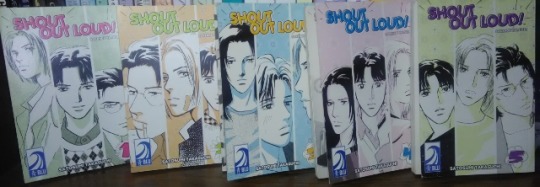
[image description: the covers of Shout Out Loud! volumes 1 through 5. Each cover features three vertical manga panels highlighting the series’ main characters.]
story & art by Satosumi Takaguchi originally serialized 1996 - 2000 (Kadokawa Shoten) English edition: 2006 - 2007 (Tokyopop)
CW: sexual harassment/assault, age gap
Y’all, Shout Out Loud! is turning 23 this year. It is old enough to have $28,500 dollars in student debt and an underpaid office job. The series is mature in another sense too: while so much of BL revolves around students or young professionals, Shout Out Loud! is about a 30-something voice actor, his family drama with his teenaged son, and his rocky relationship with a colleague.
Shout Out Loud! was favorably reviewed by manga bloggers when it was released, which is likely how I wound up discovering it and reading it originally. While I remembered the basic setup, my memories of what actually occurred in the story were super hazy. However, I recalled it being overall sweet and fluffy.
Boy, was I wrong!
The story begins when Nakaya, a high schooler and hockey player, gets sick of living with his domineering, traditional grandmother. He shows up at his father’s apartment, asking if he can live with him from now on. Shino, a 33-year old voice actor is surprised to see Nakaya; while he knew he had a son, they’d never met. Still, being a kind-hearted and earnest person, he lets Nakaya move in and tries to bond with him.
Why exactly Shino has never met his son isn’t addressed. Shino and Nakaya’s mother (who is dead when the story begins) parted on amicable terms and they lived nearby, so it doesn’t really make sense except to increase the dramatics.

[image description: Nakaya examines Shino while he sleeps on the couch, thinking, “Man, he’s completely different from the dad I’d imagined. Look at that baby-face, for cryin’ out loud.”]
Since he has a son to care for now, Shino thinks that he better step up his career. He tells his manager that from now on he’ll take any job. That is how he winds up doing a lot of voice work for BL CDs -- and how he comes into extended contact with Tenryu, a slightly older and more popular voice actor.
Bear in mind that this story takes place in the 90s. BL, while popular, is still considered seedy, deviant even. (And a lot of the BL stories he’s recording ARE super seedy.) At first, Shino is hesitant about doing such roles. But he prides himself on being a professional, so he gives it his all -- even though he can’t really relate to the roles.
Tenryu is all too happy to help Shino relate.
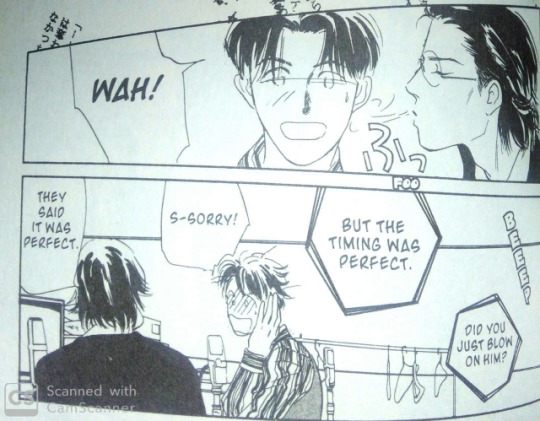
[image description: While recording lines, Tenryu leans over and blows into Shini’s ear, startling a cry out of him. The staff comment that Shino’s cry fit into the recording perfectly, but Shino is flustered.]
Here’s my main issue with Shout Out Loud!: the story wants so badly for me to buy into Tenryu as a love interest. But he checks off a lot of boxes in the “yikes!” column of BL love interests. Emotionally pushy? Check. Physically domineering? Check. Condescending? Check. Zero regard for boundaries and the words “no” and “stop”? Check. Positive qualities? I have no idea. He’s good at his job? (Aside from when he’s harassing Shino at work.)
We’re supposed to believe that Tenryu knows what Shino wants better than Shino does. As readers though, with the benefit of direct insight into Shino’s thought, we know he doesn’t want Shino kissing him and touching him. He is simply too intimidated and acquiescent to stand up for himself. His feelings towards Shino inevitably begin to warm up as the story goes on, which honestly frustrated me because Tenryu hadn’t done anything really to merit Shino’s affection beyond being a broody stereotype.
Don’t get me wrong: I love brooding (fictional) men. But they’ve got to prove that they are something beyond assholes. I couldn’t help but think back to reading Gerard & Jacques last month while reading Shout Out Loud! Fumi Yoshinaga put in the work to show that Gerard had honest-to-God positive qualities; by the end of volume 2, you could understand why Jacques liked him, even if you didn’t agree with their relationship.
Satosumi Takaguchi had 5 volumes to convince me that Tenryu was at least somewhat likeable, but she never got me there. I guess I’m supposed to feel bad for him because he recently got divorced and won’t be seeing his kid much anymore? All I could think about that was, “Good for her, I’d divorce him too.”

[image description: Tenryu leans into Shino’s space and says, “I wasn’t joking [on the radio show.] I really did kiss you. I said as much, didn’t I? But you were pretty out of it. I... I got a good thirty seconds of a kiss.” Shino is taken aback.]
But enough about those guys. Let’s talk more about Nakaya.
Of the entire cast, Nakaya is the character who develops the most. He begins the story immature, thinking only of himself as teenagers tend to do. When he first discovers his father is voicing BL CDs, he’s disgusted. But he keeps listening and eventually comes to appreciate his father as a professional.
In addition to suddenly moving in with his previously-absent father, Nakaya has a lot of other drama going on in his life. From a pregnancy scare with his girlfriend Souko to his changing feelings about hockey, he navigates through a lot of teenage troubles. The biggest storyline, however, is that he finds himself unexpectedly attracted to one of the assistant hockey coaches at his club.
Akihi is a talented, 20-something player who had to give up competitive hockey due to an injury. Nakaya finds him incredibly cool but he soon comes to suspect that his admiration of Akihi might actually be attraction.
When Shino finds out about this, he freaks a bit, thinking that listening to BL CDs might’ve somehow turned Nakaya gay. Nakaya denies this, though he concedes the CDs opened his mind to the possibility. Shino’s misinformed and homophobic reaction is pretty typical for the time this manga was created, but still tiresome to read. (Not to mention kind of hypocritical since Shino has also been questioning his sexuality.)
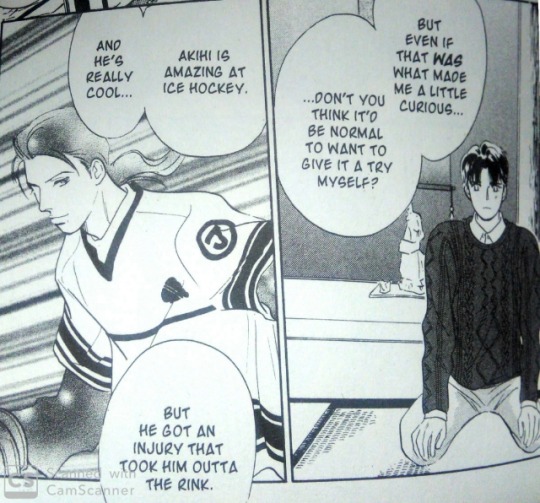
[image description: Shino sits in seiza as Nakaya tells him, “But even if [listening to the CDs] was what made me a little curious... don’t you think it’d be normal to want to give it a try myself.” He thinks of Akihi skating and continues, “Akihi is amazing at ice hockey. And he’s really cool.”]
Akihi is well aware that Nakaya is attracted to him, but wary. As he explains to Shino, Nakaya is young and has never been interested in a guy before -- his feelings could be fickle. Akihi, on the other hand, is older and actually states aloud that he is gay (pretty uncommon for BL manga of the time.) He doesn’t want to get emotionally invested only for Nakaya to change his mind. Of course, he ends up getting invested anyway.
The age gap between Nakaya and Akihi is handled somewhat well. While Akihi is a coach, he’s not in charge of Nakaya’s team, so the power imbalance isn’t as bad as it could be. It also helps that Nakaya does more of the pursuing and that Akihi isn’t his first sexual partner. But the age gap will still undoubtedly be an issue for some readers.
Ultimately, I didn’t find myself rooting for either the Shino/Tenryu relationship or the Nakaya/Akihi relationship. They both fell prey to the same sort of “Once we get started, I won’t be able to stop” nonsense and other such emotionally manipulative, rape-y bullshit. Nakaya/Akihi wasn’t as bad about it as Shino/Tenryu, but I wasn’t invested enough with Akihi as a character to care much of their relationship.
The relationship that’s at the heart of Shout Out Loud! -- and the strongest aspect of the story -- is the odd bond between Shino and Nakaya. They are father and son and both of them would like to be close. But Shino has no idea how to be a father to Nakaya and Nakaya has no idea how to be a son to Shino. As a result, they both mean well, but they also both mess up a lot. It’s awkward and sometimes painful and the most “real” part of the series.
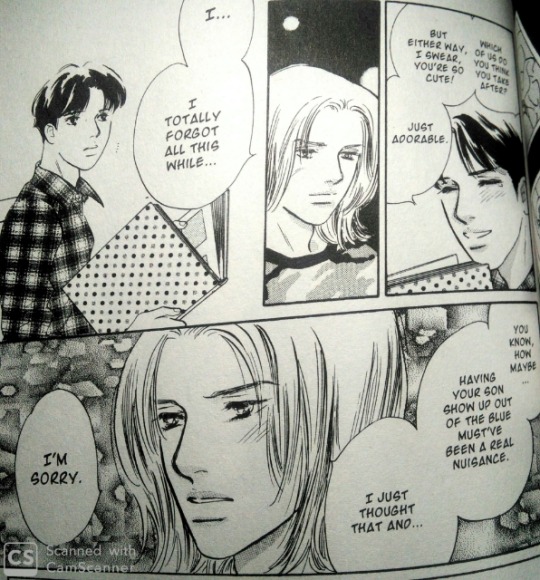
[image description: Shino checks out Nakaya’s baby photos in an album, commenting on what a cute baby he was. Nakaya is contemplative and tells him, “I totally forgot all this while... you know, how maybe... having your son show up out of the blue must’ve been a real nuisance. I just thought that and... I’m sorry.”]
To give credit where it’s due, it’s nice to read a BL with fleshed out relationships besides the romantic ones. Likewise, it’s also nice to read a BL with a heavy focus on the characters’ careers. Some of the most interesting parts were when Shino and the other voice actors were recording. (And the mash-up of Legend of the Galactic Heroes and Romance of the Three Kingdoms that they were working on was funny.) However, those elements weren’t enough to keep the series afloat for me.
In short, Shout Out Loud! doesn’t hold up for me at all anymore. I’m honestly confused about what I liked about it in the first place.
*final verdict: I’d only recommend this if you are interested in checking out older BL titles that are somewhat lengthy.
1 note
·
View note
Text
transreading - What Makes You Beautiful
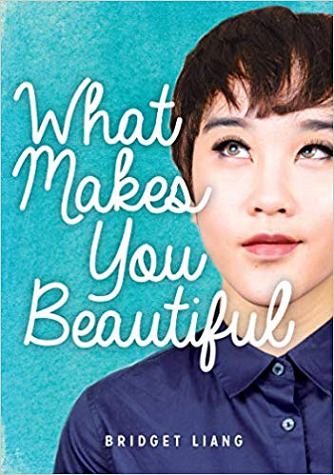
[image description: cover of What Makes You Beautiful by Bridget Liang. Off-center portrait of an east Asian teen wearing a blue button-up shirt, eye makeup, and lipstick.]
Note: like last month, this is book in which the POV character realizes they are trans over the course of the story. While the character is “Logan” for the first part of the story, she begins using the name Veronica in the final act. Midway through, while still working out her gender, Veronica asks her friends to use they/them pronouns for her. The story doesn’t have a moment in which she updates her pronouns, but I’ve made the assumption that she would ultimately go with she/her by the book’s end.
Veronica will never be the perfect half-Chinese son, but her mother and father are in denial. Despite her parents’ misgivings, Veronica switches to an arts high school to pursue singing. She quickly makes friends with several queer kids at the school. With new freedom to explore her identity, she slowly begins to realize that while she likes guys, she herself is not a guy.
What Makes You Beautiful is a really quick read. It’s short in length, with a straight-forward plot that pulls the reader along. While there are some darker moments (particularly instances of racism, homophobia, and so on), it’s by and large a sweet book -- and even downright cheesy at times. If you’re looking for a pleasant read to pass an afternoon or a flight, What Makes You Beautiful fits the bill.
There is a lot packed into this little book though, despite its brevity. The cast is highly diverse in terms of sexuality, gender, ethnicity, religion, and more. With so many different identities in play, the author gets to explore a lot of different topics naturally in the story.
For example, Veronica has doubts about being a trans girl because she fears she’s falling into the stereotype of Asian men being submissive. Veronica and her friends come into conflict with their voice teacher because all the winter concert songs are Christmas songs. One of her friends discloses that it was difficult to get his gender identity respected because of his autism. And so on and so forth. These many intersections of identity reflect the complexities of the real world and make What Makes You Beautiful stand out from similar trans coming out narratives.
There are moments, however, that might come across as over the top and strain readers’ suspension of belief. For instance, when Veronica’s father drops her off at school on the second day, he sees her visibly queer friends waiting for her and shouts at them, “Kids like you are ruining this great country!” It’s a really erratic burst of violent homophobia from someone who is otherwise portrayed as more your run-of-the-mill “I’m not bigoted!” casual bigot.
My belief was also strained by how quickly the character relationships developed. Veronica is pretty much folded into an existing friend group her very first day of school, in addition to making friends outside the group.
It’s true that friendships generally move faster with kids than adults, but I couldn’t help but raise a skeptical eyebrow when Veronica thought “I feel safe nestled between these two boys” and earnestly saying “I never had friends like you two before” within 24 hours of meeting them. Arguably, Veronica is starved for friendship since it seems she didn’t have any at her previous school. But since she was bullied, I’d expect her to be more wary.
I appreciated how well the love interest was handled. Kyle hangs around with the queer kids but is straight himself. He initially isn’t especially romantically or sexually attracted to Veronica. However, as her true gender becomes more apparent and she begins experimenting with presentation, his feelings spark. Later, he’s frank with her that this made him question his sexuality, but it doesn’t come across as an “Oh, god, am I gay??????” panic. It’s also refreshing that the guy who is indisputably the hottest in the book is Asian, since Asian men in media are so often classed as less than sexually desirable.
Reading What Makes You Beautiful was kind of nostalgic to me. I also attended an arts high school, so I remember the unique energy of being surrounded by people who are all into the same craft as you. My high school also had a reputation as the “gay school,” though students weren’t nearly as openly queer -- and the teachers weren’t nearly as queer-friendly -- as at Veronica’s school. Perhaps though my school today is more like Veronica’s than the school I remember; a lot has changed in the last decade.
To wrap up, I recommend What Makes You Beautiful if you are looking for a trans coming out narrative where the main character has a really supportive friend group (as well as the mentorship of a trans adult.) If you relate to the “It was obvious to other people, but I didn’t notice until it was pointed out” sort of trans experience, you’ll likely find a lot to relate to here.
And, of course, there is always a need for more racially diverse trans books -- What Makes You Beautiful is a very welcome addition. If you’re looking for more QPOC YA books similar to this one, I’d personally recommend Let’s Talk About Love by Claire Kann (female Black asexual main character, male Asian straight love interest) and This Is Kind of an Epic Love Story by Kheryn Callender (male Black bisexual main character, male Latino gay hard of hearing love interest).
0 notes
Text
This Month’s Reads - February
Late is better than never! Here’s what I read in February! highlights: Bury My Heart at Wounded Knee, The Scorpio Races, This Is Kind of an Epic Love Story, Being Mortal: Medicine and What Matters in the End

[image description: the covers for the books listed below]
Bury My Heart at Wounded Knee: An Indian History of the American West (Dee Brown)
Indigenous history was always at best a footnote during my school years and at worst whitewashed under buzzwords like “manifest destiny.” Thus, a lot of the history covered in this book was either new to me or only familiar in an “Oh, I recognize that name” sense. Since this book focused on a specific period, I’d like to later read something broader (and from an Indigenous writer).
I’ll be blunt: this book will break your heart, infuriate you, or both. Certain passages invoked in me a sense of horror only matched by the reading I did on the Nanjing massacre in college. It was well-written, but I don’t think I can recommend it to anyone besides the white people who dearly need to read it.
Yuri Is My Job! vol 1 (miman, translator: Diana Taylor)
Hime works for a themed cafe where the staffers roleplay as elite Catholic schoolgirls. This should be a walk in the park for Hime--for years, she’s cultivated a cute facade in hopes of attracting a billionaire husband. However, her acting chops can only carry her so far and she’s frequently baffled by the strange behavior of one particular coworker.
This was different enough from the usual “high school yuri” to keep my interest, but I wonder how long the mangaka can milk the set up for plot. I suspect that rather than developing the main couple, the mangaka will instead spend time pairing off all the cast members--which some people enjoy, but I don’t especially. I’ll give it another volume before deciding whether to drop.
The Other Me
This month’s transreading!
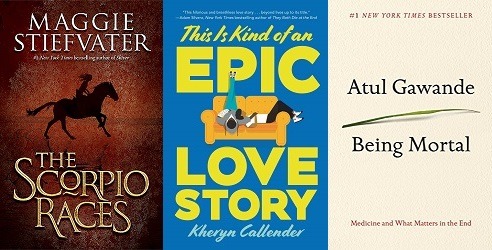
[image description: the covers for the books listed below]
The Scorpio Races (Maggie Stiefvater)
I’m a big fan of Stiefvater’s Raven Cycle series, but I had a harder time getting into her Wolves of Mercy Fall series. However The Scorpio Races, a standalone novel written between these two series, hit just the right place for me.
I’ve never been a horse person and I’ve never visited Ireland, but this book evoked a strange sense of nostalgia within me. It’s one of those narratives where the scenes and the setting feel real, bolstered by the author’s usual stylized prose. I enjoy fantasy books that take an existing bit of folklore or legend and put a unique twist to it and Stiefvater’s wild, flesh-eating water horses were very on brand for her. Another contender for favorite book of 2019.
This Is Kind of an Epic Love Story (Kheryn Callender)
Nathan Bird is a huge fan of movies, but he doesn’t believe in happy endings--especially not for real life romances. It’s hard to blame him since most of the romantic relationships he’s encountered in his short life have ended poorly. But his cynicism is put to the test when childhood friend/crush Oliver James Hernández moves back into the neighborhood.
Perhaps because this book references films so frequently, it’s easy to imagine it as a movie. I hope it becomes a movie because I think more audiences would benefit from this realistic portrayal of messy teenage friendships and romances. It was also great to see a well-rounded cast that is diverse in multiple ways. I certainly felt transported back into my high school years.
Being Mortal: Medicine and What Matters in the End (Atul Gawande)
Most people don’t like to talk to their loved ones about the end of their lives. However, as this book argues, it’s one of the most important things you can do to help the final years, months, weeks, or days go well.
Dr. Gawande treats us to a comprehensive exploration of the nature of aging, how medicine has changed aging, what tends to happen with people at the end of their life, and how we can do better for the dying and their loved ones. Both research and personal stories are told in a compelling, easy to read way. I’d recommend this book to anyone, but especially those who are either aging or caring for an aging loved one.

[image description: the covers for the books listed below]
Gerard & Jacques vol 1 & 2 (Fumi Yoshinaga, translator: unlisted)
This month’s BL LookBack!
Only Human (Sylvain Neuvel)
Final book in the Themis Files trilogy. Rose, Vincent, and Eva return to Earth after being stuck on the alien planet for nine years. Earth, however, is on the brink of World War III, and Vincent and Eva are locked in a painful family feud.
This is one of those trilogies where I loved the first book, liked the second book OK, and only felt “Eh” for the last book. Not to say that the book was bad-- it wasn’t. The series has just changed a lot since its beginning. Mostly, I miss the mystery aspect that the series formerly held. I do still love the cast for the audiobooks though-- I wish more books were fully casted when recorded.
0 notes
Text

Caring for natural (curly) hair in a setting with no access to modern hair products
So it’s the apocalypse. Your curly-haired character is on the run.They find themselves on a sudden adventure in a strange world. It’s the whatever-eth century and they’re in an environment that doesn’t exactly accommodate curly, coily haired types.
Either way, manufactured hair products are far and few between, or they’re simply not made for afro hair. Considering how your Black character handles their hair in this environment makes their circumstances more realistic and relatable.
Topics Featured in this Guide:
Hair Products found in Natural Environment
Hair Oils - Benefits and How To Extract
Protective Hair Techniques & Styles
Curly Hair Types & Hair Needs
Hair Routine Samples
Hair Straightening
FAQ
There is a writing takeaway at the end of each topic.
Brief descriptions provided after images. Contact me for fully accessible version.
Hair Products found in Natural Environment
Consider the essential needs of afro hair: water and fat.
Water (or liquid) is essential for nourishing the hair.
Fat (hair oils, creams, butters) is essential for both growth and protection.
Many curly-haired folks already use natural resources and plants to care for their hair - aka DIY hair-care. So characters concocting their own products should not be a strange concept. (I personally buy most of my natural hair products, and create my own hair masks, protein treatments, and oil blends.)
What they could use would depend on environment, time, and availability.
Hair Healthy Produce

Coconut - The all-purpose hair aid with multi forms, from oil to solid cream. Hardens in cold weather; best not to use when environment has freezing temps. Banana - Typically removed after use (hair masks, conditioners) Avocado - Applied as hair products, masks, and oils. Strawberry - Mashed and applied directly to hair or mixed with oils.
Hair Healthy Proteins, Plants, Fats

Eggs - Hardens when dry. Strong odor. Removed after use. (protein masks) Honey - Pulls moisture from air into hair - avoid during the dry winter! Shea Nuts - Made into shea butter. All-purpose hair and body care. Flaxseed - Gel made by boiling & straining flax seeds. Many DIY videos online.
Hair Healthy Herbs and Flora

Hibiscus - Sebaceous = oil-producing gland. Flowers crushed into paste or oil. Peppermint - Can rub out oil from leaves. Often used in oil form on scalp. Lavender - Often used as an oil directly applied to the scalp, or brewed as tea. Rosemary - Often combined with olive oil in use with hair; can be used alone.
More Hair Healthy Herbs and Flora

Aloe Vera - Succulent. Can extract sap directly from leaf and apply like gel. Burdock - Contains essential fatty acids and phytosterol compounds. Dandelion - Can use the roots, stems, leaves and sap for hair and skin. Rose - Common use is rose water: steep roses in boiling water to create.
Hair Healthy Products (rare or require effort to make/find)

Apple Cider Vinegar (ACV) - Diluted before use and often washed out after. Bentonite Clay - Aged volcanic ash. Combined with ACV for best activation. Oils - Key component for sealing moisture. See the next discussion. Yogurt - Base of many DIY hair products like masks and deep conditioners.
Oils for Hair
Oil is a key component to afro hair care. It nourishes and seals in moisture. Let’s discuss common hair oils and extraction methods that could, more likely, be done using homemade or historical equipment.
Oil Extraction
If oils aren’t readily available to purchase, the person would need to find or create tools to either extract the oil via pressing or heat the nuts or seeds. Consider the basic tools that have been around since ancient times. For example, the mortar and pestle. What creative use can be made out of existing tools in the person’s environment?
Hair Oils and Benefits (by potential ease to extract.)

Coconut Oil, Castor Oil, Almond Oil, Olive Oil, Avocado and Grapeseed Oil.
FYI: These aren’t the only methods or necessarily professional means of extraction. I also left off hair-healthy oils that seemed complicated to extract without high-grade equipment. So, this isn’t an all-inclusive list of oil or methods.
Natural Hair Product Creation
So what exactly would your character create? Here’s some natural hair products and potential main ingredients. May be used alone or combined.
Leave-in moisturizers: Plain water, coconut water, rose water
Leave-in creams: (protect/style) honey, shea, aloe vera, flaxseed, flora
Hair Cleansing Conditioner: plant water, coconut, honey, light oils
Hair Rinse/Co-wash: Apple cider vinegar, coconut, brewed tea water
Hair Masks: Mashed fruits, yogurt, proteins (eggs), clay, honey
DIY Recipe Search: Try keywords like “DIY natural hair” + “curly hair” “Afro hair” or search all natural hair products and read over the ingredient list. Try small home business and independent sellers (Like etsy)
More Sources:
15 DIY Hair Recipes for Almost Every Step in Your Regimen
14 Homemade Leave-in Conditioner Recipes
Best DIY Recipes for Naturally Curly Hair
Product Storage:
Most homemade products last everywhere from a few days - weeks
Extend the life of spoil-prone products via the cooling system in the work.
Honey does not spoil. Be mindful if it’s mixed with spoil-prone ingredients.
Oils can usually be kept at room temperature and last a long time.
Keeping a small bit of ready made supply may prove time-efficient. If impossible, they may opt to use products that don’t require much time and effort, and are worth their time to make in small batches or to potentially dispose of after.
Writing Takeaway - Natural Product/Oils Creation
With just the above compounds, I can see creative naturals being able to create styling products and moisturizing leave-ins, shampoos, conditioners and hair masks.
Do consider the following:
How simple or complex can their regimen be?
Would they rely more on protective hair styles in their situation?
What is the natural environment: what products are accessible?
How will they store products or must they make a new batch each use?
Can items be purchased by craftsmen or found in abandoned locations?
Can they afford to use edible plants if food is scarce? Food scraps and non-edible plants (like the flora) might be what they rely on.
What are their specific hair care needs? -Discussion on this later-
Natural Hair and Styling
LOC Method as base style
Moisture, sealing in the moisture, and protection are the basic needs for natural hair. The Liquid, Oil, and Cream (LOC) Method, or a variation of the steps, fulfills those basic needs. It can be treated as both a care routine and a style in itself. Personally, if my hair is not in a protective style, I use it every week.

Liquid - Liquid opens hair cuticles to allow moisture to enter hair strands.
Oil - Once cuticles are opened, the oil penetrates hair & seals in moisture.
Cream - Cream further locks in the moisture, and can be used as a styling agent as well to shape and define curls.
Should you use the “LOC method” by name in your work?
A modern setting? Sure. But don’t assume readers know what it means.
A fantasy setting? Probably not, unless earth and its terms carry over.
A historical setting? No. It is a newly coined term.
Protective Hair Styles
Protective hairstyles protect the hair by tucking ends away from the elements. For example, heat, air, hand and fabric manipulation. While not forever solutions (except maybe locs which are a permanent style) there’s many benefits to your character’s wearing them.
Benefits:
Hair growth retention
Saves time styling hair
Helps prevent damage and keep hair healthy
Ideal for any natural (the best style itself may depend on hair type)
Lessens hair’s need and dependence on moisture and hair products
Eliminates some hair maintenance activities (such as detangling)
Considerations:
Hair more difficult to wash and dry thoroughly.
Dryness (unable to access all tucked away hair to moisturize)
Styles kept in too long accumulates dead skin and product build up.
Uninstalling styles can be time consuming, and should be done gently.
Style gets frizzy from growth overtime and/or getting soaked in water.

Protective Styles Short-term (lasting days to weeks)
Afro puff(s) or bun(s)
Back Tuck or Roll and Tuck
Bantu knots
French roll
Pompadour
Roller set
Two-strand twists
Wash and go (low manipulation style)
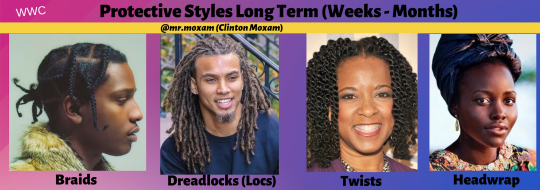
Protective Styles Long-term (lasting weeks to months+)
Braids (endless styles and patterns. Typically smaller braids last longer)
Cornrows
Dreadlocks/locs (permanent style, research the hair care)
Extensions
Flat Twists /Twists
Head wraps and hats (endless wrapping styles, colors and patterns!)
Wigs (unless glued, hair maintained underneath or often put in braids)
Writing Takeaway - Protective Hairstyles
Protective styles are an amazing way to protect the character’s hair and would very likely be the go-to for any natural in an uncertain or fast-paced environment. Just in everyday life they’re highly worn so it would especially be the case! Just remember the character needs to eventually undo whatever protective style they have installed to do some hair maintenance (washing, detangling, etc) and give their strands a rest. Also, even hair in protective styles need some attention.
Curly Hair Type and Associated Needs
Determining your hair type is important to knowing its needs. Certain ingredients work best for certain hair types. However everyone is unique and there are more factors to consider than just curl pattern (Also, most curly folks cross into a mix of hair types). There is hair thickness (width & density) and how much moisture and product your hair absorbs (porosity) to consider as well.
I will only cover curl pattern and the commonly associated needs here. To learn more about porosity, width, and density check out the FAQ under the read more.
naturallycurly.com is a great resource and is the source for the images, terms, and information provided below.

Curly Twirly (3A)
Defined loopy “S” pattern. Curls well defined and springy. Big, loose and shiny. Size: Sidewalk chalk size. Best Products: Gels and creams with light moisture and curl definition.
Curly Spirally (3B)
Well-defined, springy copious curls that range from bouncy ringlets to tight corkscrews. Size: Sharpie size. Best Products: Gels and styling creams with extra moisture and frizz control.
Curly Kinky (3C)
Voluminous, tight corkscrew curls. Either kinky or very tightly curled, with lots of strands densely packed together. The very tight curls are usually fine in texture. Size: Pencil. Best Products: Styling creams, butters, and oils. Needs gentle care.

Coily Springy (4A)
Well-defined “S” Pattern. Tight, coily, and the most fragile curls. Size: Crochet Needle or smaller.
4A Best Products & Tips: Styling creams, butters, and oils.
Clarify scalp with tea tree or jojoba oil during washes
This hair needs extra moisture and tender care
Be gentle when handling and detangling hair to avoid stress & breakage
Use thick moisturizers like mango and shea butters to maximize styles
Coily Crimpy (4B)
Less-defined “Z” Pattern. Tight, coily fragile curls. Hair bends at sharp angles.
4B Best Products & Tips: Styling creams, butters, and oils.
Add moisturizing oils before washing (pre-poo/pre-shampoo) with coconut or castor oil to help retain the natural oils in scalp
Do heat-free styles on stretched hair for maximum definition and less frizz
Air-dry hair whenever possible, or use soft cloth to gently dry.
Terry cloth will strip hair’s natural moisture and cause tension on strands
Coily Ziggly (4C)
Tight, coily, fragile curls. Curl pattern won’t clump without styling. Little to no visible definition.
4C Best Products and Tips: Styling creams, butters, and oils.
Use a cleansing conditioner with slippery elm or marshmallow root
Use a creamy humectant [like honey] as a leave-in to maximize protection
A curl defining custard or gel can stretch the coils safely for styled looks
Read the full guide here: Curly Hair Guide: What’s YOUR Curl Pattern?
Writing Takeaway - Hair type and needs
While hair type is just the start of all the intricacies of natural hair needs, it’s definitely a good start. There are other important parts to consider for real life naturals, but going off from hair type and the commonly associated needs should be enough for a story. (But read the FAQ under the read more to keep learning)
Do not get lost in the details, especially for a story that won’t need to cover tons of it. Learn enough to know what you’re talking about and can describe hair care accurately for situations that would affect hair.
Writing Takeaway - Overall:
You don’t have to be lavish in detail, but acknowledging how hair is handled here and there or in a dedicated section is thoughtful and satisfying to see included. It’s also a neutral way to show race without the use of micro-aggressions or racism. Finding the time and means for proper hair care would be a part of their life and potentially a stumbling block on the adventure, so mentioning how hair is handled during these circumstances is a fine idea.
It’s also a great means for representation.
–Mod Colette
Additional Info:
The following information will be nestled under the read more:
Hair Routine Samples - One super simple and one complex hair routine
Hair Straightening - Not ideal to maintain in survival situations, but also was a means of survival and daily living during some historical contexts
FAQ - Would any of this matter during the apocalypse? And what about natural products that attract bugs? Plus more.
Keep reading
25K notes
·
View notes
Text
BL LookBack - Gerard & Jacques
Welcome to BL LookBack, where I’m rereading some of the oldest BL series still on my shelves to see how well they hold up for me today!
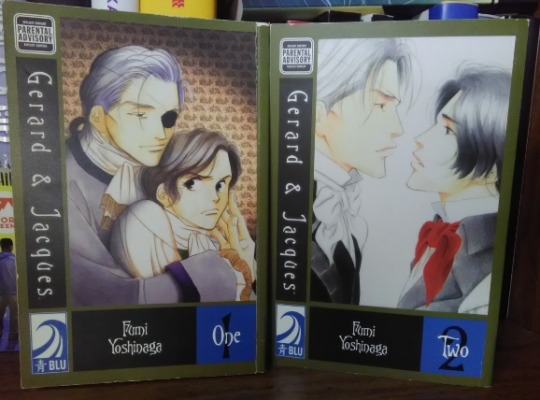
[image description: the covers of Gerard & Jacques volumes 1 and 2. On the first, an older man with an eyepatch and facial scar embraces a disgruntled teenage boy from behind. On the second, the two characters, both older, stare at each other tenderly.]
story & art by Fumi Yoshinaga originally serialized 2000 - 2001 (Biblos) English edition: 2006 (Tokyopop)
CW: rape, age gap
Fumi Yoshinaga is one of my favorite mangaka. Her diverse body of work includes award-winning alternate history (Ooku: The Inner Chambers), self-deprecating autobio comics (Not Love But Delicious Foods), and bittersweet school life drama (Flower of Life). But what she’s perhaps best known for are her many BL titles.
As a big fan, I’ve read pretty much all her manga and I usually recommend her titles quite enthusiastically. Gerard & Jacques, however, is one Yoshinaga manga that I generally do not recommend. My content warnings on this post probably give you a good idea of why, but let’s dive into it.
Set roundabouts the French Revolution, Gerard & Jacques follows the relationship of two men over the course of nine years. Jacques is the younger of the pair at just 16 when the story begins. He hails from an aristocratic family, but experiences a severe reversal of fortune: his family has sunken deep into debt and his father sold Jacques to a brothel in attempt to save the family’s wealth.
Gerard, meanwhile, is a commoner-- albeit a very wealthy one. He frequents brothels and is a favorite patron of many of the workers since he is younger and more attentive than most of the clientele. Since it’s Jacques’ first night on the job, the brothel owner decides that Gerard will be the best way to ease him into it.
Jacques, however, is understandably in shock about his new reality. He reveals to Gerard that he is an aristocrat and Gerard in turn reveals that he hates aristocrats, stating that they do nothing to earn their wealth. Furthermore, Jacques’ defense of his family’s actions angers Gerard. He makes Jacques face the facts of his situation and Jacques finally tells Gerard to do whatever he wants.
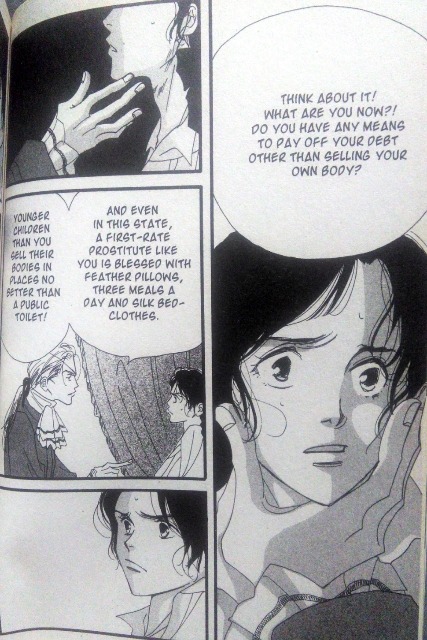
[image description: Gerard hold Jacques by the chin and tells him, “Think about it! What are you now? Do you have any means to pay off your debt other than selling your own body?” He lets Jacques go and continues, “And even in this state, a first-rate prostitute like you is blessed with a feather pillows, three meals a day and silk bed clothes. Younger children than you sell their bodies in places no better than a public toilet!”]’
Although consent is given on paper, it’s hard to call what occurs in chapter 1 anything besides rape.
Usually, this is where I’d drop a BL. However, the saving grace of Gerard & Jacques is that chapter 1 doesn’t end there. Instead, it ends with Gerard taking pity on Jacques. He buys out Jacques’ contract and challenges him to find a way to earn a living as a commoner, stating “If I see you back here [at the brothel] when I next return, I’ll scorn you from the bottom of my heart.”
Not long after, Jacques turns up at Gerard’s mansion looking for work, not realizing who lives there. Although he’s taken aback upon seeing Gerard, Jacques is still eager to prove himself. Gerard openly doubts that Jacques will be useful, but hires him regardless.
Here is the crux of Gerard & Jacques: the story’s setup is deeply problematic. But where a less talented mangaka would slip into weak character development and tired tropes in favor of exploiting the scenario’s raciness, Yoshinaga works hard to prove there is a story worth reading here. As for how successful she ultimately is… your mileage may vary.
Let’s talk about what’s done well first.
Yoshinaga excels at writing characters with complex emotions and motivations. Jacques is naive and repressed when it comes to sexual matters. However, he is also an intelligent, hard-working, and prideful person who isn’t afraid to tackle tasks that other people think are below him. After being turned out by his family, what he wants most is to prove his worth.
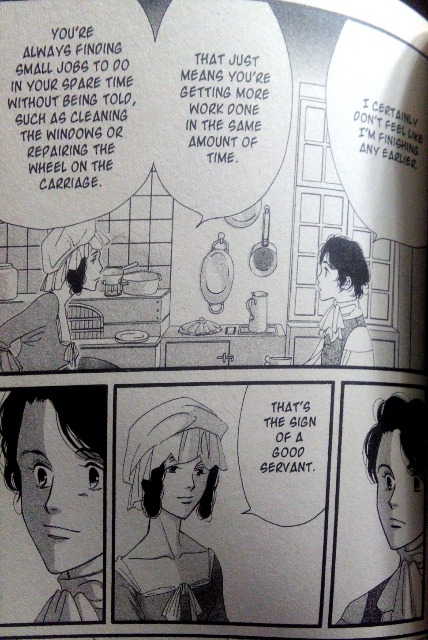
[image description: a maid praises Jacques for working hard and finding tasks to do without being told, ending with “That’s the sign of a good servant.” Jacques is pleased.]
Jacques, for obvious reasons, got a poor first impression of Gerard, so he’s surprised to learn that Gerard treats his servants very kindly and is well-liked by therm. As a self-made man, Gerard has enough reason to dislike pampered, frivolous aristocrats. (Note: Gerard made his fortune by penning erotica. There’s certainly some meta going on here, as that is also how Yoshinaga built her career.)
However, it doesn’t take long for Yoshinaga to divulge Gerard’s past and reveal the real reason behind his ire. I won’t go into the details because it’s all obviously spoilers. But, in short, Gerard was hurt badly by someone he loved and has never forgiven them-- nor has he forgiven himself for being blinded by his love.
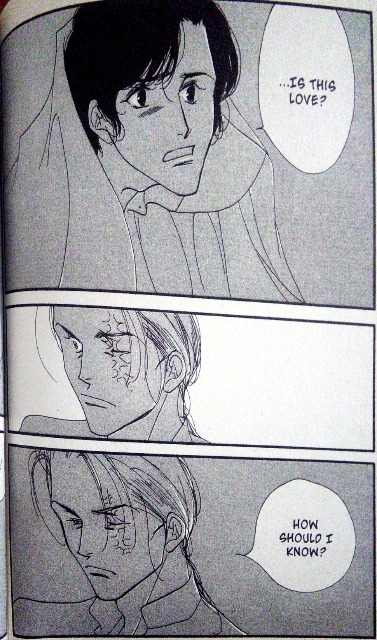
[image description: Jacques asks Gerard, “Is this love?” Gerard is surprised by the question, then he looks down and responds, “How should I know?”]
As someone who primarily reads to experience other people’s emotions, I appreciate the care that Yoshinaga takes in crafting believable personalities and depicting the characters’ emotions clearly on the page. She isn’t afraid to use several panels to simply show a small shift in a character’s expression. In relatively few chapters, she covers a lot of emotional ground while showing how the two main characters’ feelings for each other change.
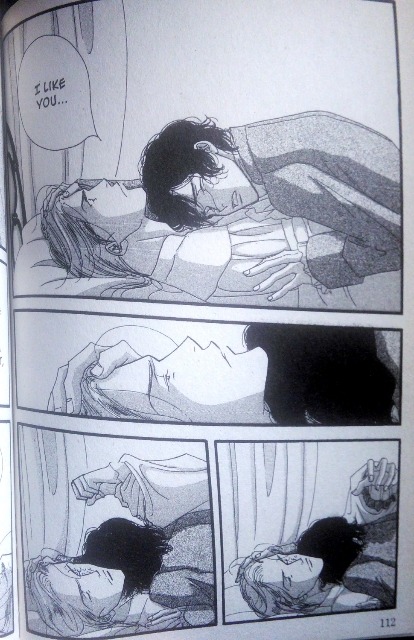
[image description: Jacques lays on Gerard’s chest and pets his hair, saying “I like you...” Unseen by Jacques, Gerard moves as if to put his arm around Jacques and return his embrace, but pulls away.]
Yoshinaga also manages to pack an awful lot of plot into just two volumes without the story feeling too rushed. Nearly a decade goes by! There’s the events that shift Gerard and Jacques relationship, story lines that reveal backstory, and, of course, plots driven by Revolutionary France politics. There’s so much political and legal talk at some parts, in fact, that you might momentarily forget you’re reading a BL. While some readers may be uninterested in such plots, I personally enjoy romance stories that have something else going on within them besides romance.
Finally, I greatly appreciate that Yoshinaga steered clear of the Bury Your Gays trope. It’s a spoiler to even say so, but I think it’s important to know, especially for queer readers: neither Gerard nor Jacques die. I won’t say anything more about the ending than that.

[image description: Gerard and Jacques are arguing whether Jacques should flee the country alone or if Gerard should come with. Jacques stands his ground, saying “I won’t go unless you do!”]
Now let’s talk about the bad stuff.
The number one issue I take with Gerard & Jacques is its double standard surrounding sexual consent. In essence, the reader is meant to presume that since Jacques ultimately enjoys the sexual pleasure he receives from Gerard, that means that his consent is good and golden-- and thus it’s not rape. By contrast, when another character forces sexual attention on people, it’s plainly depicted as sexual assault and rape. Obviously, that’s not how it works in real life.
There’s also a weird, pseudo-incestuous vibe. Gerard is quite a lot older than Jacques (roughly twice his age when they first meet, I think). Furthermore, Jacques’ background and kind-heartedness remind Gerard of a girl who he considered his daughter. Gerard even tells Jacques when he is older, “I loved you like my own child, but that’s not all now. I love you like my lover.” While no actual incest occurs, I’m sure this alone will turn off plenty of readers.
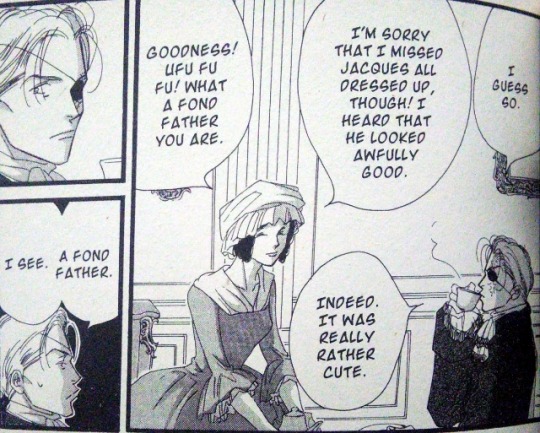
[image description: Gerard comments to the maid that Jacques looked cute dressed up in aristocratic attire. She remarks, “What a fond father you are.” He thinks on this, then repeats, “A fond father. I see.”]
Finally, there’s some unfortunate Man in a Dress style transphobia. Gerard disguises himself as a woman briefly for plot reasons and, in short, some characters note that the look doesn’t suit him. The way it’s executed is much gentler than most other Man in a Dress joking I’ve seen, but it’s still bothersome.
Overall, Gerard & Jacques isn’t bad. In fact, I’d say that Yoshinaga pulls off the story rather well within the confines of the problematic scenario. However, I think the story would’ve been far better without the rape between the two leads.
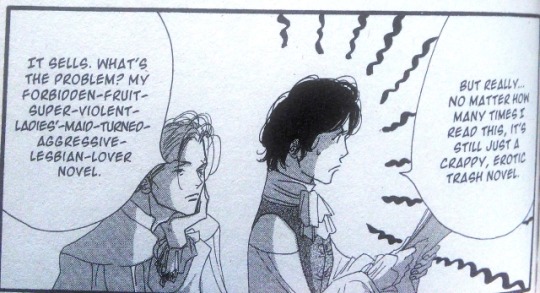
[image description: Jacques frowns at a manuscript and says, “No matter how many times I read this, it’s still just a crappy, erotic trash novel.” Gerard replies, “It sells. What’s the problem?”]
If this review has made you curious despite the warnings, I do think it’s a worthwhile read so long as you are prepared for objectionable content. But for people put off by the various warnings, I’d encourage you to check out something else by Fumi Yoshinaga. My two personal favorite series from her are Antique Bakery (workplace slow burn drama) and What Did You Eat Yesterday? (half cookbook, half slice of life about a middle aged gay couple.) Neither of these are actually BL in the proper sense, but both prominently feature gay main characters.
*final verdict: I was put off by its premise when I first read it and my feelings on it haven’t much changed. It’s well-done, but the creator has other works I’d recommend more.*
3 notes
·
View notes
Text
transreading - The Other Me

[image description: cover of The Other Me by Suzanne “Xan” van Rooyen. Two teenagers are shown facing forward, only half of each displayed. One has long, curly red hair and looks straight-forward, clear-eyed. The other has an asymmetrical fringe and a brooding gaze.]
An important note before I begin: the transgender POV character realizes they are trans over the course of the narrative. Since the character’s chosen name is a bit of a spoiler and only appears on the final page, I will use their previous name “Treasa” here. However, I will be using he/him pronouns for Treasa in my review.
Treasa feels like an alien at his all-girl Catholic school in South Africa. He doesn’t understand the girls there and even feels different from his female best friend. He’s obsessed with Resa, the alien male lead of a sci-fi show he follows, but does Treasa want to be with Resa or be him?
His confused feelings come to a head when Gabriel (who bears a striking resemblance to Resa’s actor) starts playing piano accompaniment at Treasa’s choir practices. Gabriel, meanwhile, is dealing with his own trauma and feels uncomfortable being held up as Treasa’s ideal.
I related a lot to Treasa’s connection with a fictional character and the way he explored his own identity via writing fanficton. Throughout The Other Me, Treasa is working on a fic in which Resa is romantically involved with Tristan, Treasa’s original character. Treasa projects a lot of himself and his developing relationship with Gabriel onto Tristan and Resa respectively. As someone who also first explored my gender through writing slash fic, I thought this was a really great characterization that’s not often seen, but a fairly common experience.
The writing in The Other Me is clean and the story is easy to follow. Treasa and Gabriel’s storylines are given equal weight (though I’ve focused a lot more on Treasa here) and their perspectives are distinguishable from the other. The pacing is good for the most part, though I thought the ending felt a little rushed.
If you like reading messy relationships and high school drama, this might be right up your alley. However, readers should expect the same kind of slut shaming and misogyny that they might also hear in the halls of a high school. Unfortunately, it’s not often challenged.
The story suffers from a “I’m not like the other girls” vibe. While such a feeling is a common experience among many AFAB trans and nonbinary people, it’s somewhat problematic here because the “other girls” in the book are a bit of a monolith. Thus, the concept of womanhood in the book is very narrow.
By and large, the female characters are feminine, straight, and at least a little catty-- the epitome of stereotypical teen girly girl. The book doesn’t really explore the many different ways there are to be a woman; Treasa just rejects the singular way presented. The only times that other types of womanhood are discussed are in passing and usually in the context of “why can’t you be like that instead of trans?” This likely echoes the experience of many AFAB trans and nonbinary people, but to me the narrative would’ve been stronger if Treasa were more aware of the options available for women and still stood fast in his identity.
One element that I thought was particularly well done was Treasa’s relationship with his mother. She is protective and reluctant to recognize that Treasa is an independent-minded teenager, not a small child. Their dynamic felt authentic, with a lot of raw emotion. The power struggle between them over Treasa’s bodily autonomy is likely to resonate with a lot of trans readers.
Something that people may struggle with is Gabriel’s father. It’d be generous to say that Gabriel and his father have been fighting since Gabriel’s mother’s death. It might be more accurate to say that his father is outright abusive. However, the story humanizes the father by revealing The Reason for his behavior. Despite this, I think most readers would still find his father’s actions unforgivable.
Gabriel doesn’t exactly forgive his father either. While it seems he may like to reconcile with his father eventually, his feelings on the matter are understandably complicated. I could relate to this storyline and the broken parent-child relationship felt realistic to me, but other readers may be put off by any attempt to explain or excuse abuse.
A final note: I feel wholly unqualified to comment extensively on the racial dynamics of a country that is not my own. That said, this book struck me as very white for a story set in South Africa, which is around 80% Black. Not to say there are no Black characters at all-- there’s a few minor characters, to my best knowledge-- and not to say that there aren’t plenty of books by white Americans guilty of the same issue. It’s just something that stood out to me, (along with the rather jarring line “I make like a Kenyan and sprint out”).
With all this in mind, if you are looking for a gay trans man coming out narrative and you are prepared to read through some challenging content, I think The Other Me is worth your time. Right now, it’s even available for free on Kindle Unlimited.
1 note
·
View note
Text
This Month’s Reads: January
In an effort to remember more of what I read, I’ve decided to track properly this year and record my thoughts in brief. Thus, here are This Month’s Reads.
highlights: I’ll Be Gone in the Dark, The Ghost Bride, They Both Die at the End, and a lot of comics

[image description: the covers for the books listed below]
Heart of Gold vol 1 (Eli Baum & Viv Tanner) Dunant is a faith healer. Ionel is a pianist losing his sight. Every week Ionel attends Mass hoping to be cured, but Dunant turns him away. Meanwhile, a series of strange deaths casts a shadow over this gorgeously illustrated tale.
While not much especially romantic occurs, our two leads are clearly leaning on the edge of something. Ionel is intrigued by the priest, both due to his own needs and Dunant’s lonely aura. Dunant confesses his innermost doubts to Ionel inadvertently, leading to some interesting discussions of faith. Those discussions and the art’s tender beauty were the highlights for me. The pacing was slow for my tastes and some scenes felt like they could’ve been edited or cut to avoid repetition.
*
I Hear the Sunspot vol 1-3 (Yuki Fumino, translator: Stephen Kohler)/ A brash college student named Taichi meets fellow student Kouhei by chance. Kouhei’s good looks attract attention, but he feels isolated due to his hearing loss. Taichi begins taking notes for Kouhei in exchange for lunch and a slow burn romance ensues.
This is one of my favorite manga from recent years, so I always reread the previous volumes when a new one comes out. Truly, the series improves with each volume. With the expanding cast, the mangaka explores different perspectives on and experiences with deafness. Volume 3 introduces Ryu, who is Deaf and lives life quite happily without hearing-- in contrast to Kouhei, who fears losing his remaining hearing.
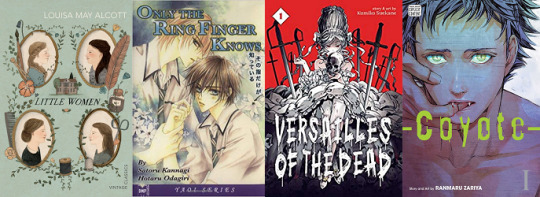
[image description: the covers for the books listed below]
Little Women (Louisa May Alcott) I read Little Women for the first time during a young adult literature class in college. I must confess that I remembered very little of the plot, so reading it again was like starting entirely new. I forgot how funny it can be! The moral lessons for the most part still apply today, though I disagreed somewhat with a few of them.
The most intriguing and frustrating thing for me is Jo March, who reads to me as very much queer, though what flavor is debatable. My personal interpretation (and I’ll admit that I’m projecting) is that Jo is transmasculine and somewhere on the ace spectrum. And, personally, I believe the author was some flavor of queer as well.
*
Only the Ring Finger Knows (Satoru Kannagi & Hotaru Odagiri, translator: Sachiko Sato) This month’s BL LookBack!
*
Versailles of the Dead vol 1 (Kumiko Suekane, translator: Jocelyne Allen) I know very little about French history, so I have no idea how faithful this tale is to actual events. However, I don’t think the actual Marie Antoinette was her twin brother, possibly possessed by a demon. Likewise, I’m quite certain there were no zombies rampaging France.
Usually zombie stories and historical dramas don’t interest me. But I have a weakness for crossdressing plots, despite them usually being problematic. Surprisingly, this registered fairly low on the problematic scale-- so far. And while I wasn’t exactly riveted, it was compelling enough to persuade me to preorder the second volume. I hope this receives an anime adaptation because it could be quite spooky under the right director.
*
Coyote vol 1 (Ranmaru Zariya, translator: Christine Dashiell) It took me several attempts to finish this BL because the first chapter put me off. As expected of “werewolf in heat” erotica, there’s some dubious consent issues. However, once I finally got past that first chapter, the dramatic plot lured me in.
Werewolves are half-forgotten by the general populace, but certain groups still hold a grudge against them-- including the Galland mafia family, which our human lead “Marleen” is set to take over soon despite personally having no issue with werewolves. Meanwhile, our werewolf lead Coyote accepts a job to kill the Galland heir, not realizing it’s the very man he’s fallen in love with. Overall, the story has its fair share of objectionable issues, but I’m compelled enough to keep reading for now.

[image description: the covers for the books listed below]
I’ll Be Gone in the Dark: One Woman's Obsessive Search for the Golden State Killer (Michelle McNamara) I think that if a person were going to only read one true crime book ever, this one would be a good pick. The actual true crime element of the book is great. The writer excels at bringing the people to life-- the victims, the cops, the witnesses, even the unknown killer. She has a real knack for adding just enough evocative detail to paint a picture without sensationalizing.
However, what I find most compelling is how thoughtfully she examines her own motivations and actions-- and thus those of the reader as well. What is it about true crime that attracts people? And how can we pick apart these real life tragedies while respecting human life?
*
The Prince and the Dressmaker (Jen Wang) Frances is a seamstress working hard for a pittance and dreaming of grander things. Her designs catch the attention of Prince Sebastian, who is in need of both a dressmaker and a secretkeeper. The two become friends, often making a splash around town with Sebastian dressed up as the glamorous Lady Crystallia. However, some secrets can’t be kept forever.
This comic has been on my to-read list for a while based solely on the cute cover and title. It was indeed cute (I especially loved the comedic off-model panels) but the story went deeper and was more rewarding than I anticipated. However, content warning for a character being outed in a humiliating manner; it’s more intense than you might expect for comic like this.
*
Life Outside the Circle (H-P Lehkonen) Artist Sami leaves big city Helsinki for remote, rural Finland. There he meets his new neighbor Juha and Juha’s young daughter Maiju. Culture shock and romance ensues.
I had the good fortune to meet the cartoonist at TCAF 2018. I enjoyed the book I picked up from him there, as well as the queer Finnish comics panel he moderated. So I figured I’d check out more of his work and he didn’t disappoint-- this comic had plenty of genuine humor, heart-warming moments, and realistic angst. I especially appreciate the blasé approach to Sami being transgender; it’s just one of his traits and while it does influence some things in the story, overall it’s not that important.
*
The Ghost Bride (Yangsze Choo) An early contender for favorite book of 2019 appears! This book has it all: romance, spooky thrills, adventures in other realms, wit, plenty of food, and an upcoming Netflix miniseries!
Our hero is Li Lan, who has attracted the unwanted romantic attention of local rich boy Lim Tian Ching. Not only is he rude and selfish, he’s also dead! As Li Lan struggles to ward off Lim Tian Ching’s invasive spirit, she becomes more and more drawn into the world of the ghosts-- as well as the secrets of the Lim family and her own. I loved all the rich detail, both for the real life historical setting and the fantasy settings. Highly recommended and I’m very excited for the TV series as well.
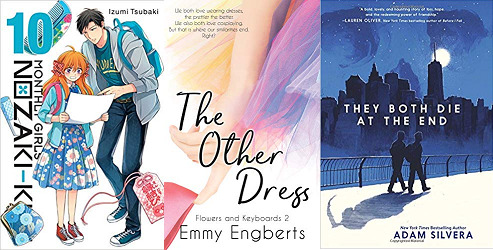
[image description: the covers for the books listed below]
Monthly Girls’ Nozaki-kun vol 10 (Izumi Tsubaki, translator: Leighann Harvey) Another volume of Nozaki-kun, another plea from me for another season of the anime, please! Not to say that the manga isn’t good-- it’s great-- but this is a case of the anime being better, in my opinion.
Anyway, the rom-com misadventures of Nozaki, Chiyo, and the crew continues. Relationship development continues to be slow, which is no issue for me since that’s hardly what I’m reading for. (That said, Kashima and Hori seem like they might be on the verge of becoming a couple? Maybe?) Since I read Nozaki as aroace, I’m pleased to report that he remains as aroace-seeming as ever. Poor Chiyo, however, is crushing on him harder than before, to the extent that it’s starting to become kind of creepy.
*
The Other Dress (Emmy Engberts) This month’s transreading!
*
They Both Die at the End (Adam Silvera) I’m well aware that I’m in the minority here, but I actually enjoy reading major character death when it’s done well. “Enjoy” might be the wrong word; what I mean to say is that I appreciate the experience of being moved so powerfully by a work of fiction.
My main concern going into They Both Die at the End was that the deaths would feel cheap. After we get to know the main characters (who are young and healthy) so well and they’ve been through so much together, what kind of death could possibly feel authentic and “worth it” to the reader? I won’t spoil the end for anyone, but I thought the author came through strongly. Thoughtful and emotional with intriguing world building.
0 notes
Text
BL LookBack - Only the Ring Finger Knows
Welcome to BL LookBack, where I’m rereading some of the oldest BL series still on my shelves to see how well they hold up for me today!

[image description: cover of Only the Ring Finger Knows; two teenage boys in school uniforms pose intimately with rings prominently displayed on their fingers]
story by Satoru Kannagi / art by Hotaru Odagiri originally serialized 2001 - 2002 (Takuma Shoten) English edition: 2004 (Digital Manga Publishing)
Only the Ring Finger Knows was a pioneer in the United States--one of the first BL published here and an early hit. I feel safe in saying that nearly everyone who had an interest in BL in the 2000s at least knew of it, if not read it. Many considered it the ideal “beginner’s BL.”
I recall liking it well enough back when I first read it ~10 years ago. I even remember the plot keenly thanks to its simplicity and unique elements. It felt odd (dare I say queer) to reread it now that I am closer to 30 than 20, out of the closet, and a lot better informed on problematic tropes. Still, I’m pleasantly surprised at how well it holds up all these years later (relatively speaking.)
Wataru is an ordinary teenager who, by chance, meets Kazuki, a popular upperclassman. Kazuki is the prince of their high school, with what seems like the entire female student body crushing on him. In fact, even girls at other schools adore Kazuki. He’s handsome, smart, athletic, rich, and-- above all else--known for his kindness.
Wataru, therefore, is shocked when Kazuki treats him rudely during their first encounter. He continues to be a jerk to Wataru during future meetings. Why does he treat me differently? Wataru wonders. As time goes by, his thoughts become more and more preoccupied with Kazuki.

[image description: Kazuki yanks a handkerchief from Wataru’s grip and tells him, “Wash your face at home.”]
I’m sure you can all tell where this is going. It’s an old plot, made popular for centuries by works like Pride and Prejudice. What distinguishes Only the Ring Finger Knows from similar stories is its one quirky plot element: the rings.
At Wataru and Kazuki’s school, rings are popular. Two friends might wear matching rings on their right ring fingers to show off their bond. A student can signal that they are single by wearing a ring on their middle finger. And, most importantly, couples wear matching rings on their left ring fingers.
Wataru isn’t keen on the trend, but he does have a ring that he wear on his middle finger due to his personal attachment to it. And (gasp!) Kazuki happens to have a ring that is the exact same design.
You can probably guess where this is going as well.
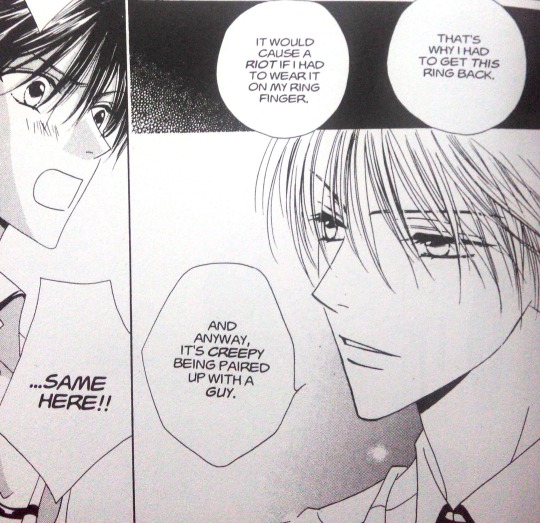
[image description: Kazuki says that he had to get his ring back from Wataru because “it’s creepy being paired up with a guy.” After a moment, Wataru says, “Same here!”]
The plot is beat-by-beat predictable, which isn’t necessarily a detriment within the romance genre. What the story does notably well is the character writing.
Wataru is relatable for readers: aware that he doesn’t stand out and righteously upset at being treated poorly for no reason. He stands up for himself, pushing back against Kazuki’s bad behavior verbally and-- when necessary-- physically. He’s kind to his sister, doing her the favor of delivering a friend’s present to Kazuki even though he’s loathe to talk to Kazuki more. Perhaps most importantly, he’s honest to himself about his feelings, even as they confuse him.

[image description: Wataru presents Kazuki with a large, wrapped gift. Kazuki is taken aback and Wataru notes that Kazuki’s surprise seems genuine even though Wataru thinks Kazuki must get gifts frequently.]
Kazuki, meanwhile, is compelling for readers primarily because they suspect what his true feelings are and wait on bated breath for those feelings to be revealed. It’s always satisfying when a proud character admits something that they view as a vulnerability. However,
Kazuki as a character ages poorly for me. The “he teases you because he likes you” mindset persists even today, but it’s becoming less tolerable for modern readers and may turn some off this story.
In addition, Kazuki leans dangerously into the “bully but secretly gay” trope. It doesn’t feel quite accurate to call Kazuki a bully-- he doesn’t purposefully seek Wataru out to harass him or humiliate him in front of peers. But he does nettle Wataru during every interaction. Whenever Kazuki feels the conversation is becoming too intimate or he has exposed too much of himself, he sabotages the conversation by pissing Wataru off.

[image description: Kazuki leans forward so that Wataru is backed into a wall. Wataru looks irritated. With just inches between their faces, Kazuki says, “Thanks for the special delivery.”]
I’ve no doubt that these traits would make him an unacceptable love interest for many readers. However, some people enjoy such characters and Kazuki never does anything to Wataru that absolutely crosses the line into irredeemable. (Your mileage may vary.)
Furthermore, when Kazuki finally confesses his feelings to Wataru and admits that he had no hope of Wataru ever liking him back, it’s instinctive to respond to that kind of vulnerability. Who among us has never feared that they valued a relationship far more than the object of their affections, whether it be a lover, a crush, a friend, or a family member?

[image description: Wataru tells Kazuki that he threw his ring away. Kazuki is shocked.]
The other element of the story that doesn’t age well is its attitude towards homosexuality. While Only the Ring Finger Knows is not as egregious in this respect as some other BL, it’s still tiring to read things like “It’s creepy being paired up with a guy,” and “You sure you aren’t ‘funny,’ that way?”
Also, the characters exhibit a prevailing belief that being gay is something a person chooses. Even as Wataru accepts his own unexpected feelings for Kazuki, he thinks to himself, “Someone as popular as Kazuki has no reason to turn to another man for a partner.” (Despite the fact that he himself didn’t “turn” to Kazuki and fell for him quite naturally.) Likewise, Kazuki’s cousin makes a comment to Wataru’s sister that she’s surprised Kazuki didn’t “choose” to fall in love with her instead of Wataru, since Wataru and his sister look so much alike.
In addition, the most chaste displays of romantic affection between two men are treated as borderline obscene. In an epilogue, Wataru and Kazuki kiss briefly in front of Kazuki’s young niece. It’s meant to be a humorous and somewhat shocking moment, captioned with “in front of a child.” There’s nothing scandalous about the moment though, so the “humor” falls flat and ultimately it comes off as prudish at best and homophobic at worst.
As typical of BL from this era, there’s zero discussion of the troubles queer people face in a conservative society. The few people who find out about Wataru and Kazuki’s feelings are supportive. Neither Wataru nor Kazuki seem to think that they might be ostracized at school when people realize they are dating-- they mention that rumors may occur, but nothing nefarious. Indeed, the word “gay” never comes up in the story, nor does any related terminology.
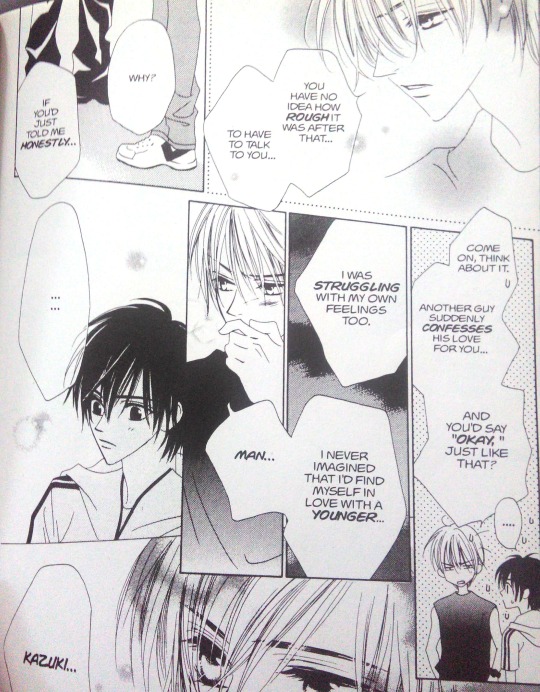
[image description: Kazuki confesses that he found it hard to speak with Wataru because he was struggling with his feelings, adding “I never imagined that I’d find myself in love with a younger... man.”]
Many BL (old and new) have an issue of treating their female characters poorly. While none of the actual female characters in Only the Ring Finger Knows receive bad treatment, it’s troublesome how the manga paints basically every female student as being obsessed with Kazuki. And I do mean obsessed-- a mob of girls show up at Kazuki’s house on his birthday uninvited and end up rioting.
Despite these grievances, I did enjoy my reread of the manga. It’s a classic tale told well, with each scene showing how Wataru and Kazuki circle around each other, slowly drawing closer. The emotional payoff when they get together is satisfying, even if I can’t help but begrudge Kazuki his happiness somewhat.
*final verdict: still recommended with mild disclaimers*
1 note
·
View note
Text
transreading - The Other Dress

[image description: cover of The Other Dress by Emmy Engberts. Closeup of a person in a colorful skirt lifting a piece of pink fabric with one finger.]
As someone who spends a lot of time and energy on fandom, I’m thrilled that more and more writers are integrating fandom experiences into books. However, it’s still relatively hard for me to find English-language novels that specifically focus on anime/manga fandom. And it’s even rarer yet for me to find something that reflects my specific niche: queer anime/manga fandom.
But, lo and behold, The Other Dress appeared before me.
A quick run-down of the plot: Elliot is crossplaying at a con for the first time and nervous. He quickly meets Izzy, a talented cosplayer well-known on the local scene. They fall into an easy friendship that soon becomes a romance. However, Izzy is inexperienced with dating, mostly due to worrying how her partners might react when they learn she is a trans woman. Elliot, meanwhile, has some insecurities of his own.
It’s clear that the author, Emmy Engberts, has intimate knowledge of being transgender, being an animanga fan, and being a transgender person within animanga fandom. There’s a lot of insight in The Other Dress that you likely wouldn’t get from someone who simply researched the topics.
One thing that stood out to me early on is Izzy being concerned about getting misgendered at an anime convention-- not because the con might have a lot of ignorant people, but because cons are spaces with a lot of gender play and fluidity. (As many trans people can attest, it’s sometimes easier to be read as the correct gender in more conservative spaces with rigid binary perceptions of gender.)
I also especially appreciated the attention given to how gender identity is a spectrum and it’s normal to have doubts about where exactly you fall on it. Elliot has an extended conversation with a close friend about how it bothers him that people assume he must be trans since he crossdresses-- but, at the same time, he does personally wonder if he might be trans. In addition, I related to Elliot being annoyed at the way his parents always seem to be on the verge of questioning him but staying silent, while at the same time privately acknowledging that he doesn’t want to explain every detail to them.
As much as I enjoyed all the great transgender insights, it was also refreshing that the story does not revolve entirely around gender issues. Elliot and Izzy deal with problems that any couple might have, such as in different cities and struggling with depression. Furthermore, both the main characters are huge geeks with friends and hobbies outside the queer realm. Overall, I’d say The Other Dress strikes a good balance between acknowledging how big of a role a trans identity can play in someone’s life without making it seems like that is all there is to their life.
One big caveat concerning this book though: it would have benefited greatly from more thorough editing, both on a line-by-line level and on a developmental level. Grammatically speaking, readers should be prepared to encounter a lot of comma splices, missing words, incorrect punctuation, etc. This may turn some readers off entirely; I powered through on account of the book being self-published. I know how expensive it can be to hire an editor on your own dime.
As for the larger issues, I found the pacing to be a little unbalanced. About half the book follows Elliot and Izzy over the course of the con weekend. The other half of the book takes place over the course of several weeks (months)? It struck me as uneven, though other readers may not mind.
In addition, I found it strange that the book essentially had two prologues-- one labeled Before and one labeled as Chapter One, but taking place two years before the rest of the book. That amount of set-up felt unnecessary to me and honestly confused me in the beginning. (We see Izzy meeting some new people for the first time, and then shortly afterwards they are referenced as having been friends for years.)
Finally, the book is told from both Elliot and Izzy’s points of view, but their character “voices” were largely the same. They do have different personalities, so I wish their unique traits and perspectives were reflected more in the writing style for each voice.
These issues aside, I think trans readers will enjoy The Other Dress, particularly those looking for stories where the non-trans partner isn’t totally clueless or readers who also love anime/manga fandom like me (though you may experience some secondhand embarrassment.) If you enjoy stories like this, I heartily recommend that you also check out the comic Crossplay by Niki Smith-- assuming you are an adult and down for some queer, geeky erotica.
0 notes
Text
Talking with writers online
Their stories: Amazing grammar, soaring vocabulary, beautiful imagery and prose which flows like a river.
In chats: no capitalisation or punctuation, swears like a sailor, misspellings everywhere, acronyms and abbreviations every five words, idek
#this remains the most True and About Me post ever to cross tumblr dot com#inspiration#even if only in a i'm not alone sense lol
278K notes
·
View notes
Photo

a prayer for the artist
( patreon | ko-fi )
40K notes
·
View notes
Note
Hi! A lot of my villains fall into 'bad for the sake of bad' category, and I don't know how to fix it. I just can't think of any other way that could keep their actions the same or remaining the villain without them just being straight up evil. I know that's lazy, but I'm not sure what to do about it. Do you have any ideas? Your blog is a gift to writers everywhere, thank you so much~
Hello! One thing to understand when writing realistic villains is that each villain thinks of themself as a victim and a hero of their own story.
Maybe their feelings of having been wronged come from a place of legitimacy: maybe they were abused, brutalized, marginalized, or bullied, but they use this as an excuse to do the exact same thing to others.
Or maybe, it comes from a place of privilege: the villain is used to getting what they want and thinks they’re owed something by the world around them (a significant other, for example. I’d love to read a novel in which the villain is Ross from Friends) and become enraged when they’re denied.
Sometimes, villains will think that their destructive actions are helping others. These are often the scariest to me, because they’re also the most historically familiar: Hitler, for example, legitimately believed he was doing his country a service by brutally murdering millions of innocent and blameless people.
There’s also a great post on the subject of writing villains right here. Maybe I’ll soon do a post myself, because villains are an interesting subject and very fun to develop.
I hope this helps, and happy writing! <3
76 notes
·
View notes
Text
Microaggressions in Fiction
When authors write about experiences that are not their own, particularly when these experiences involve a marginalized community, they may feel apprehensive, afraid, or anxious about the backlash they might receive if they do something wrong, which there is a 99.9% chance that they will. Here, I will outline some microaggressions that I notice when reading, each relating to anti-blackness and misogyny (as well as misogynoir, which is a combination of the two), as those are microaggressions that I face myself. If anybody has anymore to add, or would like to add some not related to anti-blackness or misogyny, feel free!
1. Comparing our skin to food. (coffee, toffee, caramel, chocolate, etc.)
2. Getting AAVE wrong. My degree is in linguistics, and although I am by no means an expert, I do speak a variant of that particular dialect, and can discern when it is being used improperly. Perceptions of Black English speech patterns are very racialized and politicized, and it annoys me when someone (probably white lbr) throws words that they’ve heard Black people say into a sentence without considering if this would be generated by the grammar of that dialect. If you have questions regarding a particular dialect, speak to someone who speaks it. Say your dialogue out loud to them and ask if that sounds grammatical.
3. The “Black Girl Best Friend” trope. We are not born sidekicks. We are not all sassy walking stereotypes. Some of us do embody stereotypes about Black women, and that’s perfectly fine! But do not stuff your Black girl character with stereotypes and call them character traits. Additionally, do not write your Black Girl Best Friend characters so that she is only there to uphold your white protagonist and step in when they need her. (Think Bonnie from The Vampire Diaries)
4. Hypermasculine, hypersexual Black men characters. Just don’t do it. This stereotype is harmful and contributes to a wider fear and distrust of Black men and black bodies.
5. The Magical Negro. We are not here to provide your protagonist with sage wisdom or solemn advice
6. Colorism/”Palatable Blackness,” LISTEN. If your Black characters all look like Zendaya or Jesse Williams and have curly or wavy, rather than kinky hair? You might wanna consider the colorism ingrained in that choice, fam.
7. Not knowing how kinky hair behaves. This is related, kind of, to the above. Watch some natural hair videos or summn before deciding what hairstyle you want your black character to have, because kinky and coily hair behaves VERY differently from straight and wavy hair, and that should be considered when writing scenes.
5K notes
·
View notes
Text
How to write a morally gray character:
Have their ideals be right but their methods be wrong
Make it seem like their dastardly methods are really the only way to achieve the goal for the “greater good.”
Have them develop from a flat antagonist to a well-rounded protagonist
How to not write a morally gray character
wah my childhood was hard
104K notes
·
View notes
Link
here you go fam. 3.5k words of advice on writing lesbian smut and additional excerpts from some good examples.
2K notes
·
View notes
Note
And what about deaf characters?? Any tips????
Here is a post on deaf dialogue (from a 75% deaf person.)
Here is a short masterpost on resources writing deaf characters.
Here is a respected (deaf) author’s advice on writing deaf characters.
I try to get my resources from actual deaf people as much as possible, as hearing people tend to make a lot of common errors and assumptions when talking about them or trying to portray them.
I hope this helps, and happy writing! <3
227 notes
·
View notes